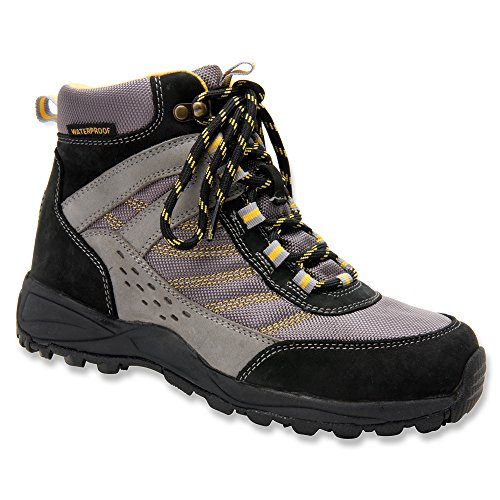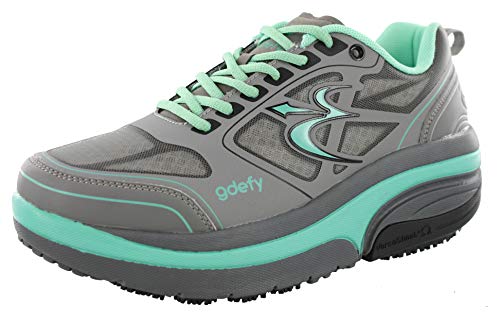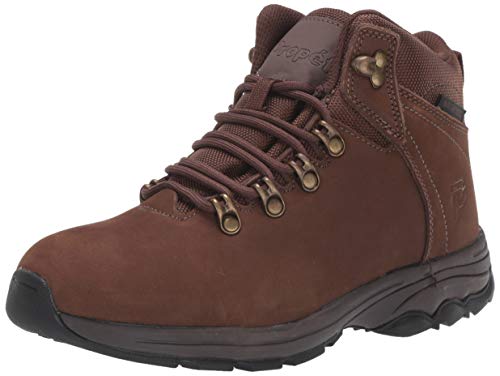Best Women’s Orthopedic Hiking Boots (Reviews)
When you have various foot conditions, hiking isn’t the no.1 activity to practice. Typically, hiking puts a lot of pressure on your feet, which can aggravate your current foot problems.
Wearing orthopedic shoes will help you get the proper posture and maintain you comfortable and pain-free while providing hiking support. Orthopedic boots may be needed to change the way you’re walking, reducing the pressure on your heel, and alleviate the pain. Nowadays, orthopedic shoes come with features that help you hike, and you need to look for the right ones.
Top Women’s Orthopedic Hiking Boots
1. Drew Glacier – Women’s Waterproof Orthopedic Boot
Drew Glacier – Women’s Waterproof Orthopedic Boot looks as rugged and dependable as any other hiking boots but come with the features that orthopedic shoes put on the table.

See reviews and pricing on Amazon
The boots are made with leather and fabric so that they will feel comfortable from the first wear. They feature waterproof upper and lining, which will stop water from getting inside and moisture to escape from your feet.
The polyurethane footbed is comfortable and features added heel padding for increased comfort and soft support. The toe room is complete, and your toes sit comfortably. There are no seams and rough edges to alter the comfort inside, and the boots provide efficient motion and control support. The oblique toe, rigid heel counters, and steel shank provide the support and protection you need while hiking.
Traction and stability won’t be an issue either, as the boots come with a non-marking outsole that is resistant to slippage and oil. It’s a lightweight, yet durable sole. The shoes run a tad small but make a perfect option for people with orthopedic problems.
Even if looks aren’t essential on hiking boots, we have to note that these boots will catch your attention. The grey and black parts make a great combination, whereas the yellow accents give them a youthful and fresh vibe for a better appearance.
If you’re dealing with orthopedic problems and you like light hiking on well-maintained tracks, the
2. Gravity Defyer Proven Pain Relief Women’s G-Defy Ion Athletic Shoes For Plantar Fasciitis, Heel Pain, Knee Pain
Gravity Defyer Proven Pain Relief Women’s G-Defy Ion Athletic Shoes For Plantar Fasciitis, Heel Pain, Knee Pain will make the right choice.

See reviews and pricing on Amazon
The boots are made with fabric and synthetic, providing comfy wear from the beginning. The mesh fabric upper is breathable, so your feet will remain dry all day long while hiking in the summer. The upper mesh is durable but also flexible and highly breathable.
The toe box is bottomless and spacious, providing the best comfort for bunions, diabetes, and the shared space you need for toes while hiking. The spacious build of the boots allows you to add removable insoles for customized wear. Using custom orthotic inserts will make your hikes more comfortable. The collar is softly padded for ankle comfort, whereas the tongue will protect from debris or dirt that could affect the comfort.
The boots are made with the omega sole with hidden VersoSchock technology. Therefore, the shoes will provide a secure fit for hiking while absorbing the shock and impact, giving back energy for the whole body. Please note that it’s only the all-black ion boots that are slip-resistant, creating a better choice for hiking.
3. Propét Women’s Pia Hiking Boot
When you’re determined to buy hiking boots that will take a fair amount of time, leather boots are the right option. The Propét Women’s Pia Hiking Boot is made with 100% nubuck leather and will get softer with each wear, adjusting to your foot’s unique shape.

See reviews and pricing on Amazon
The boots are made with soft nubuck and mesh lining that is Scotchgard treated for resistance to water and stains. The open cell PU is breathable, pushing moisture away from the feet and providing the healthy and relaxed footbed you need for all-day comfort.
The collar and tongue are softly padded, whereas the heel counter is well made for superior heel support. The metal hooks are sturdy, and the lace up style helps you tie the laces as tight or loose you need for the best fit.
The midsole is EVA, providing the soft support and comfort you need when hiking, whereas the rubber outsole ensures adequate traction even on rugged terrain. You will customize the boots according to your specific needs since the footbed is easy to remove. Even if the shoes aren’t the best looking boots, they make a dependable and durable choice for hiking with orthopedic problems.
What features should you identify in the best orthopedic boots for hiking?
Hiking is a challenge, but wearing the proper pair of hiking boots will make it less difficult for your aching feet and legs. It doesn’t take rocket science to know that the hiking boots should protect against the elements so that the risk of injuries, cuts, punctures, or wet elements is profoundly reduced. Support and cushioning are also necessary, so the selection process is complicated nine times out of ten. Here are some features to pay attention to when looking for orthopedic hiking boots.
Arch support
It’s common for orthopedic boots to come with orthotic insoles that offer excellent arch support. The arch support should control the excessive pronation, which alters the foot functioning, causing heel and foot pain.
Orthotic insoles will lower the pressure on the ball of the foot and heel, transferring some of your body weight to the arch. When the boots lack the arch support, the arch won’t adequately spread the pressure under the foot, causing pain.
Overpronation will make the leg rotate internally, causing stress on the lower back, knee, and hip. Orthotic insoles with adequate arch support are essential for reducing the strain on your lower back, knee, and hips and proper alignment of the leg and foot.
Depth
Orthopedic boots are made on a shoe last with extra depth for taking the thick insoles. The orthotics will provide a more comfortable and loose fit, reducing the pressure points on your foot.
Width
When looking for orthopedic hiking boots, you should be able to pick from various widths. Typically, you will be able to select between medium, complete, and extra-wide. Narrow and extra extra-wide boots are also available.
Protective interior
You want the orthopedic boots to come with a soft and smooth interior and create a pleasant contact with the foot. It should eliminate pressure points and provide gentle support for less strenuous hiking. Eva midsole and breathable lining are some of the features creating the soft support inside.
Make sure that the insole is breathable and moisture-wicking for providing a fresh feel inside the boots.
Wide toe box
You will need comfort for your toes when hiking, no matter if you have orthopedic problems or not. If the toe room is wide and spacious, the toes will not get cramped, so they will feel comfortable throughout descending. The toe box should also be protective against roots, rocks, and impact, reducing the risk for stone bruising.
Build
The upper body should be made with stretchable material tough enough to protect against the elements yet flexible for best comfort throughout hiking. The soft leather will stretch and adjust to the shape of your foot in time, but the mesh and stretchable materials also make good choices. However, they’re not as long-lasting as leather.
Seamless build and smooth edges will reduce the risk of blistering, improving overall comfort.
Sole
Unlike regular hiking boots, orthopedic boots have to provide grip and traction while remaining soft enough for the foot. The rubber sole is a very dependable option, as it’s tough enough to make intense use of hiking, yet soft and flexible for comfortable hiking.
FAQs
Q: Should you see a professional before choosing your boots?
A: It’s not mandatory, but an orthopedic clinician is the best to advise you on the type of arch support, the amount of cushioning you need. Even if you can identify that you need orthopedic shoes, you’re able to know which kind of support, padding, and other features you should look for in your hiking boots.
Q: How do orthopedic shoes work?
A: Orthopedic boots are measured and created to match the uniqueness of your feet perfectly. Orthopedic boots will align the feet and ankles for best support, reducing pain and risk of injuries. They will create a more effective walking pattern.
Q: Should you use orthotic insoles?
A: Orthotic insoles can be used with orthopedic boots for reducing the pressure on the heel and the ball of the foot, as they spread the body weight evenly across the foot. They can also alleviate the pain of the most stressed areas in the knees, hips, and back by properly aligning the foot and leg.


